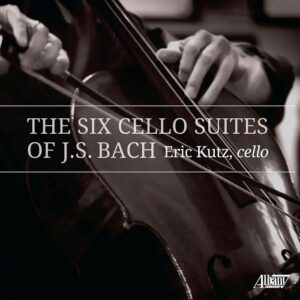
Eric Kutz. Bach Cello Suites Albany TROY 1973. Digital release and CD . Auditioned on Presto streaming. HI Res 96Hz 24bit
Released March 2024
CD recorded May 3.5 and 7 2022 at Dekelbom Concert Hall University of Maryland
Also, You tube video performance completed in 4 and a half hours during lockdown in an empty hall.
https://www.youtube.com/watch?v=mYsCHA0iIRM
Recorded at the Guarneri Hall, Chicago, Illinois, on July 6, 2020
Kutz performs on a cello by Raffaele Fiorini (Bologna, 1877) and a bow by Jacob Eury (Paris, 1810).
Introduction.
To quote the record company blurb:
“Cellist Eric Kutz says that this recording had its roots in the pandemic. Facing cancellation of numerous performances, he turned to the Bach Suites, bringing to his performances of them the life experience of an adult”. This might be seen as a sideways swipe at the very young age of some performers such as Narroway and Enders. Hopefully not as my journey to date suggests that there is no direct relationship between the age of a performer and the merits of their recording. There is so much more than age and experience which contributes to the result! Indeed, Mr Kutz enlightens us in the booklet provided with the CD release. He makes the very reasonable observation we learn from books but know from life.
Kutz certainly has paid his dues, is probably approaching 50 years of age and so certainly has been patient. To quote the publicity release,
“His diverse collaborations cut across musical styles and have ranged from cellist Yo-Yo Ma to jazz great Ornette Coleman. He is active as a teacher, a chamber musician, an orchestral musician, and a concerto soloist. A graduate of The Juilliard School and Rice University, he is currently on the faculty of the University of Maryland School of Music. “
The recording.
This is a fine recording with excellent sound stage capturing the full breadth of tone, dynamics, and frequency that are on offer here. There is very little extraneous noise picked up to distract. Technically, this is an excellent recording with nothing to betray the relatively short recording time.
The Music.
The overall style of this performance by Kutz is well in the Romantic camp with a generally legato style, lots of well-chosen dynamics and variations in tempo. Vibrato is plentiful, but there is good articulation. What I like is that there are a variety of voices used by Kutz often within the same movement, so we get powerful strong bold statements, and later on soft and quiet phrases. Then there are short playful moments, and quirky unexpected sounds of which more later. There is occasionally a forced landing on a low note which I find off putting, namely in the fourth Prelude. However, what prevails throughout the recording is the love of the music that Kutz displays with sincerity and passion.
I have gone into a bit more detail about my findings of the first and fifth suite.
The First Suite.
The Prelude is flowing and gentle with moments of repose. I like the way the semiquavers of the 2nd and 4th beats in the opening bars are played with separate bows but in a legato style which ensures regularity of the rhythm which can be lost when a player plays all eight semiquavers in one bow. The Allemande has very appealing and sensitive phrasing usually in chunks of 2 or 4 bars. However, to my ears, they are not all joined up together. It brings to mind a patchwork quilt made up of lots of lovely fragments of cloth.
The Courante is lively and vigorous, but the polyphony of the writing doesn’t become clear and therefore it feels a little two dimensional.
Starting a bit fiercely the Sarabande then becomes more subtle with the lovely tune of this movement being more evident.
Minuets are played lightly and move along nicely but I would have liked a bit more spring in the step. The Gigue is a little ponderous in places, especially at the start but lightens up.
Fifth Suite
Here, in the Prelude introduction we see broad sweeping tone and resonant lower registers, with just a few forced moments. The Fugal section for me loses a bit of momentum and direction with its frequent variations in tempo (admittedly subtle). In the Allemande I would have liked a better sense of the horizontal phrasing. To my mind it tends to meander a bit too much. The Courante displays some of the qualities that I recollect from the masters of the 60s and 70s with incisive and bold bowing. In the Sarabande there is lots of dynamics but still for me a missed opportunity to pick out the key notes enough to create a sense of movement. The first Gavotte has a suitably earthy sound. The second Gavotte has a short couple of bars at the end played “sul ponticello” which is playing the bow very close to the bridge bringing out lots of harmonics and faint fundamental notes. Kutz uses this unusual (quirky) device elsewhere and the point is lost on me I have to say! The Gigue is played very lightly and daintily. More like flowers blowing in the breeze than dancers leaping around!
Conclusion.
This is a most worthy rendition of the Suites. I like the musical phrasing and thoughtful variations of tone, dynamics and tempo. I would have liked more rhythmicity, and a sense of direction and momentum from clearer horizontal phrasing. That I think would have brought out the implied polyphonic nature of Bach’s composition more clearly. There is nothing to quibble about with technical aspects such as tuning and articulation. Definitely worth a listen.
Charles.